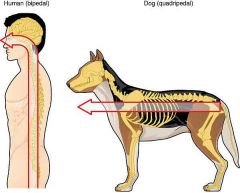![]()
![]()
![]()
Use LEFT and RIGHT arrow keys to navigate between flashcards;
Use UP and DOWN arrow keys to flip the card;
H to show hint;
A reads text to speech;
23 Cards in this Set
- Front
- Back
|
neuraxis |
the axis of the central nervous system. It denotes the direction in which the central nervous system lies. During embryological development, the neuraxis is bent by various flexures, contributing to the mature structure of the brain and spinal cord. |
|
|
How does the neuraxis differ in animals and humans? |

|
|
|
dorsal |
– toward the back away from the ventral (stomach side) The top of the brain is considered dorsal because that is the way it is in 4 legged animals |
|
|
ventral |
toward the stomach, away from the dorsal side |
|
|
rostral |
toward the front or face side |
|
|
caudal |
toward the back or rear |
|
|
anterior |
toward the front |
|
|
posterior |
toward the back |
|
|
afferent |
conveying impulses toward the central nervous system |
|
|
efferent |
conducting outward from a part or organ ; specifically : conveying nervous impulses to an effector, a bodily organ (as a gland or muscle) that becomes active in response to stimulation |
|
|
lateral |
toward the side (away from the midline) |
|
|
medial |
toward the midline, away from the side |
|
|
ipsilateral |
on the same side of the body (e.g. two parts on the left or right side of the body) |
|
|
contralateral |
on the opposite side of the body (e.g. one on the left, one on the right) |
|
|
3 planes of section |
Coronal, sagittal, horizontal |
|
|
Coronal section |
A coronal section is cut in a vertical plane, from the crown of the head down, yielding a frontal view of the brain’s internal structures |
|
|
horizontal section |
so-called because the view or the cut falls along the horizon, is usually viewed looking down on the brain from above—a dorsal view. |
|
|
sagittal section |
is cut lengthways from front to back and viewed from the side. (Imagine the brain split by an arrow—in Latin, sagitta.) Here, a cut in the midsagittal plane divides the brain into symmetrical halves, a medial view. |
|
|
3 main sections of the brain |
Forebrain Midbrain Hindbrain |
|
|
Forebrain |
1. Telencephalon (cortex, limbic system, basal ganglia) 2. Diencephalon (thalamus, hypothalamus) |
|
|
Midbrain |
tectum, tegmentum |
|
|
Hindbrain |
(pons, medulla, cerebellum) |
|
|
Longitudinal fissure |
the gap that divides the two hemispheres |

